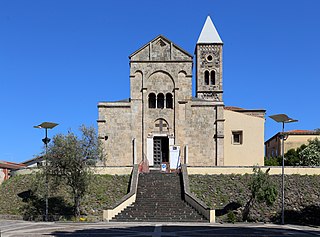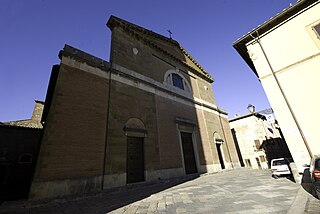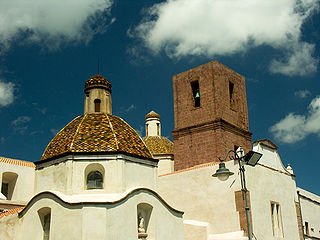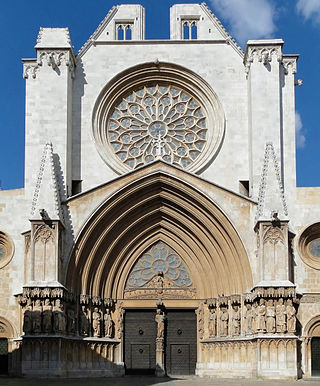
The Archdiocese of Cagliari is a Latin archdiocese of the Catholic Church centred on the city of Cagliari. It holds the Primacy of Sardinia.

Prato Cathedral, or Cathedral of Saint Stephen, is a Roman Catholic cathedral in Prato, Tuscany, Central Italy, from 1954 the seat of the Bishop of Prato, having been previously, from 1653, a cathedral in the Diocese of Pistoia and Prato. It is dedicated to Saint Stephen, the first Christian martyr.

The Diocese of Lanusei is a Latin Church diocese of the Catholic Church in Sardinia; before 1986 it was the diocese of Ogliastra. It is a suffragan of the archdiocese of Cagliari.

Pistoia Cathedral, or Cathedral of Saint Zeno is the main religious building of Pistoia, Tuscany, central Italy, located in the Piazza del Duomo in the centre of the city. It is the seat of the Bishop of Pistoia and is dedicated to Saint Zeno of Verona.

Pavia Cathedral is a church in Pavia, Italy, the largest in the city and seat of the Diocese of Pavia. The construction was begun in the 15th century on the site of two pre-existing Romanesque, "twin" cathedrals. The cathedral houses the remains of St. Sirus, first Bishop of Pavia, and a thorn purported to be from the Crown of Thorns worn by Christ. The marble facing of the exterior was never completed.

Santa Giusta Cathedral, now a minor basilica is the former cathedral of the abolished Diocese of Santa Giusta, in Santa Giusta, province of Oristano, Sardinia, Italy. The dedication is to Saint Justa of Cagliari who, according to the tradition, was martyred here at the time of the Roman emperor Diocletian, with her companions Saints Justina and Aenidina. Almost entirely built in sandstone, it is considered one of the most important examples of Sardinian Romanesque architecture.

Arezzo Cathedral is a Roman Catholic cathedral in the city of Arezzo in Tuscany, Italy. It is located on the site of a pre-existing Palaeo-Christian church and, perhaps, of the ancient city's acropolis.

Colle di Val d'Elsa Cathedral is a Roman Catholic cathedral in Colle di Val d'Elsa, Tuscany, Italy. Anciently a pieve of the Holy Saviour, it is now dedicated to Saints Albert and Martial. Formerly the episcopal seat of the Diocese of Colle di Val d'Elsa from its creation in 1592, it is now a co-cathedral of the Archdiocese of Siena-Colle di Val d'Elsa-Montalcino.

Bosa Cathedral, dedicated to the Immaculate Conception, is a Roman Catholic cathedral in Bosa, Sardinia, Italy. It is a co-cathedral of the Diocese of Alghero-Bosa; before the creation of the merged diocese in 1986 it was the seat of the Bishop of Bosa.

The Primatial Cathedral of Tarragona is a Roman Catholic church in Tarragona, Catalonia, Spain. The edifice is located in a site previously occupied by a Roman temple dating to the time of Tiberius, a Visigothic cathedral, and a Moorish mosque. It was declared a national monument in 1905.

Cagliari Cathedral is a Roman Catholic cathedral in Cagliari, Sardinia, Italy, dedicated to the Virgin Mary and to Saint Cecilia. It is the seat of the archbishop of Cagliari.

Teramo Cathedral is a Roman Catholic cathedral in Teramo, Abruzzo, central Italy, dedicated to the Assumption of the Virgin Mary and to Saint Berardo, patron saint of the city. It is the seat of the Bishop of Teramo-Atri. Built in Romanesque-Gothic style, it was consecrated in 1176.

Noto Cathedral is a Roman Catholic cathedral in Noto in Sicily, Italy. Its construction, in the style of the Sicilian Baroque, began in the early 18th century and was completed in 1776. It is dedicated to Saint Nicholas of Myra, and has been the cathedral of the Diocese of Noto since the diocese's establishment in 1844.

The Basilica of St. Sebastian is a church in Barcellona Pozzo di Gotto, Sicily, Italy, raised to the status of a minor basilica in 1991.

St Patrick's Cathedral is a heritage-listed Roman Catholic cathedral on James Street, South Toowoomba, Toowoomba, Toowoomba Region, Queensland, Australia. It was designed by Toowoomba architect James Marks and was built from 1883 to 1935. The site of the cathedral was originally a church and school known as St Patrick's Church School. In 1899, the school was moved to make way for the building of the cathedral and in 1959 renamed as St Saviour's School. St Patrick's Cathedral was added to the Queensland Heritage Register on 21 October 1992.

Avellino Cathedral is a Roman Catholic cathedral dedicated to the Assumption of the Virgin Mary and Saint Modestinus in Avellino, Campania, Italy. It is the seat of the bishops of Avellino.

Latina Cathedral is a Roman Catholic cathedral, dedicated to Saint Mark, situated in the centre of the city of Latina, Lazio, Italy. It is the seat of the bishops of Latina-Terracina-Sezze-Priverno.

The Co-Cathedral of Saint Mary of the Assumption and Saint Catellus is the Roman Catholic duomo or cathedral of Castellammare di Stabia in the metropolitan city of Naples, in the region of Campania, Italy. It is the main church in Castellammare di Stabia and it is co-cathedral of the Archdiocese of Sorrento-Castellammare. It was built in 1587 and was consecrated in 1893. Inside on display for worship is the statue of Saint Catello, the patron saint of the city.

The Cathedral of Our Lady of the Snows is the main place of Roman Catholic worship in Nuoro, Sardinia, and the cathedral church of the diocese of Nuoro.

Fano Cathedral is the principal church of Fano, Marche, Italy. Originally the seat of the bishop of Fano, since 1986 it has been the episcopal seat of the Diocese of Fano-Fossombrone-Cagli-Pergola. In January 1953 Pope Pius XII elevated it to the rank of a basilica minor.



















